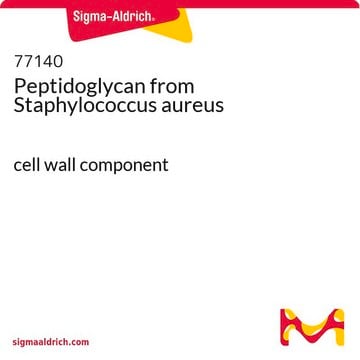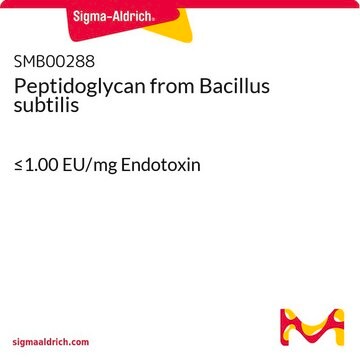L2515
Lipoteichoic acid from Staphylococcus aureus
bacterial cell wall polymer
Iniciar sesiónpara Ver la Fijación de precios por contrato y de la organización
About This Item
Productos recomendados
origen biológico
Staphylococcus aureus
Nivel de calidad
formulario
lyophilized powder
grupo funcional
phospholipid
tipo de lípido
polymerizable lipids
Condiciones de envío
ambient
temp. de almacenamiento
2-8°C
Descripción general
Lipoteichoic acid (LTA) is a linear polymer of phosphodiester-linked glycerol phosphate covalently bound to a lipid. The C2 position on the glycerol-phosphate is usually glycosylated or D-alanylated. LTA is amphipathic due to the presence of the negatively charged backbone of glycerol phosphate and the hydrophobic lipid. The lipid portion is bound hydrophobically to the cell membrane, whereas the polyglycerol phosphate portion extends into the cell wall.
Lipoteichoic acid (LTA) is a teichoic acid attached to a lipid abundant on Gram-positive bacteria cell wall. LTA is a pathogen-associated molecular-patterns (PAMP) recognized by Toll-like receptor 2 (TLR2), This recognition leads to the activation of NF-kB.
Aplicación
Lipoteichoic acid from Staphylococcus aureus has been used:
- to investigate the binding properties of SpHyastatin to lipopolysaccharides and lipoteichoic acid using enzyme-linked immunosorbent assay (ELISA)
- to measure the interleukin (IL-6) produced in splenocytes using a sandwich ELISA
- as a toll-like receptor 2/6 (TLR2/6) agonist to explore its potential to induce tumoricidal M1 macrophage phenotype
Acciones bioquímicas o fisiológicas
Lipoteichoic acid (LTA) is a complex component of cell walls of Gram-positive bacteria that are involved in a wide range of cell processes such as the stimulation of immune responses and cell signaling pathways. LTA differs between species of gram-positive bacteria. Lipoteichoic acid from Streptococcus aureus may be used to compare its structure, immunogenicity and functions versus other bacterial LTAs.
Lipoteichoic acid (LTA) is a complex component of the cell walls of Gram-positive bacteria that are implicated in a wide range of cellular processes such as the stimulation of immune responses and cell signaling pathways. LTA differs between species of Gram-positive bacteria. Lipoteichoic acid from Streptococcus aureus may be used to compare its structure, immunogenicity, and functions versus other bacterial LTAs.
Producto relacionado
Referencia del producto
Descripción
Precios
Código de clase de almacenamiento
11 - Combustible Solids
Clase de riesgo para el agua (WGK)
WGK 3
Punto de inflamabilidad (°F)
Not applicable
Punto de inflamabilidad (°C)
Not applicable
Equipo de protección personal
Eyeshields, Gloves, type N95 (US)
Certificados de análisis (COA)
Busque Certificados de análisis (COA) introduciendo el número de lote del producto. Los números de lote se encuentran en la etiqueta del producto después de las palabras «Lot» o «Batch»
¿Ya tiene este producto?
Encuentre la documentación para los productos que ha comprado recientemente en la Biblioteca de documentos.
Los clientes también vieron
Simin Rezania et al.
Cancer cell international, 14, 54-54 (2014-06-27)
Many types of tumors are organized in a hierarchy of heterogeneous cell populations with different molecular signature. Such heterogeneity may be associated with different responsiveness to microenvironment stimuli. In the present study, the effects of lipopolysaccharide (LPS) and lipoteichoic acid
S Morath et al.
The Journal of experimental medicine, 193(3), 393-397 (2001-02-07)
Lipoteichoic acids (LTAs) have been proposed as putative Gram-positive immunostimulatory counterparts to Gram-negative lipopolysaccharides. However, LTA from Staphylococcus aureus, the clinically most frequent Gram-positive pathogen, was inactive after purification. Here, a novel isolation procedure to prepare pure (>99%) biologically active
Nien-Tzu Chou et al.
Evidence-based complementary and alternative medicine : eCAM, 2012, 735396-735396 (2013-01-11)
Chlorella sorokiniana (CS) is a unicellular green alga. The extracts of Chlorella have been used as treatments for relieving hypertension and modulating immune response. The detailed mechanisms are not clear yet. In this study, we sought to study the molecular
Varenka J Barbero-Becerra et al.
World journal of gastroenterology, 17(10), 1317-1325 (2011-04-02)
To study the role of gram-positive and gram-negative bacteria in the pathogenesis of liver injury, specifically the activation of inflammatory mediators. Peripheral blood mononuclear cells of 20 out-patients were studied, 10 of them with cirrhosis. Peripheral blood mononuclear cells were
Ingmar J J Claes et al.
Microbial cell factories, 11, 161-161 (2012-12-18)
Probiotic bacteria are increasingly used as immunomodulatory agents. Yet detailed molecular knowledge on the immunomodulatory molecules of these bacteria is lagging behind. Lipoteichoic acid (LTA) is considered a major microbe-associated molecular pattern (MAMP) of Gram-positive bacteria. However, many details and
Nuestro equipo de científicos tiene experiencia en todas las áreas de investigación: Ciencias de la vida, Ciencia de los materiales, Síntesis química, Cromatografía, Analítica y muchas otras.
Póngase en contacto con el Servicio técnico









